Cranial anatomy of Besanosaurus leptorhynchus Dal Sasso & Pinna, 1996 (Reptilia: Ichthyosauria) from the Middle Triassic Besano Formation of Monte San Giorgio, Italy/Switzerland: taxonomic and palaeobiological implications
- PMID: 33996277
- PMCID: PMC8106916
- DOI: 10.7717/peerj.11179
Cranial anatomy of Besanosaurus leptorhynchus Dal Sasso & Pinna, 1996 (Reptilia: Ichthyosauria) from the Middle Triassic Besano Formation of Monte San Giorgio, Italy/Switzerland: taxonomic and palaeobiological implications
Abstract
Besanosaurus leptorhynchus Dal Sasso & Pinna, 1996 was described on the basis of a single fossil excavated near Besano (Italy) nearly three decades ago. Here, we re-examine its cranial osteology and assign five additional specimens to B. leptorhynchus, four of which were so far undescribed. All of the referred specimens were collected from the Middle Triassic outcrops of the Monte San Giorgio area (Italy/Switzerland) and are housed in various museum collections in Europe. The revised diagnosis of the taxon includes the following combination of cranial characters: extreme longirostry; an elongate frontal not participating in the supratemporal fenestra; a prominent 'triangular process' of the quadrate; a caudoventral exposure of the postorbital on the skull roof; a prominent coronoid (preglenoid) process of the surangular; tiny conical teeth with coarsely-striated crown surfaces and deeply-grooved roots; mesial maxillary teeth set in sockets; distal maxillary teeth set in a short groove. All these characters are shared with the holotype of Mikadocephalus gracilirostris Maisch & Matzke, 1997, which we consider as a junior synonym of B. leptorhynchus. An updated phylogenetic analysis, which includes revised scores for B. leptorhynchus and several other shastasaurids, recovers B. leptorhynchus as a basal merriamosaurian, but it is unclear if Shastasauridae form a clade, or represent a paraphyletic group. The inferred body length of the examined specimens ranges from 1 m to about 8 m. The extreme longirostry suggests that B. leptorhynchus primarily fed on small and elusive prey, feeding lower in the food web than an apex predator: a novel ecological specialisation never reported before the Anisian in a large diapsid. This specialization might have triggered an increase of body size and helped to maintain low competition among the diverse ichthyosaur fauna of the Besano Formation.
Keywords: Besano Formation; Cranial anatomy; Ichthyosauria; Longirostry; Marine reptiles; Middle Triassic; Monte San Giorgio; Osteology; Phylogeny; Shastasauridae.
© 2021 Bindellini et al.
Conflict of interest statement
Cristiano Dal Sasso is an employee of the Museo di Storia Naturale di Milano, Italy. Torsten Michael Scheyer is an employee of the Paläontologisches Institut und Museum, Universität Zürich, Switzerland.
Figures

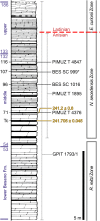
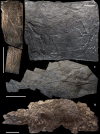
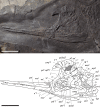


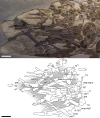
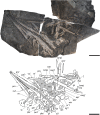
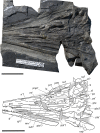
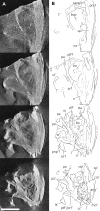

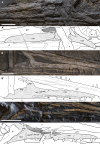

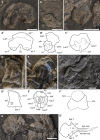



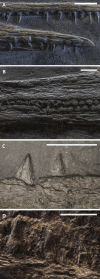





Similar articles
-
Postcranial anatomy of Besanosaurus leptorhynchus (Reptilia: Ichthyosauria) from the Middle Triassic Besano Formation of Monte San Giorgio (Italy/Switzerland), with implications for reconstructing the swimming styles of Triassic ichthyosaurs.Swiss J Palaeontol. 2024;143(1):32. doi: 10.1186/s13358-024-00330-9. Epub 2024 Sep 10. Swiss J Palaeontol. 2024. PMID: 39263671 Free PMC article.
-
Revision of the Middle Triassic coelacanth Ticinepomis Rieppel 1980 (Actinistia, Latimeriidae) with paleobiological and paleoecological considerations.Swiss J Palaeontol. 2023;142(1):18. doi: 10.1186/s13358-023-00276-4. Epub 2023 Sep 11. Swiss J Palaeontol. 2023. PMID: 37706074 Free PMC article.
-
Orthoceratoid and coleoid cephalopods from the Middle Triassic of Switzerland with an updated taxonomic framework for Triassic Orthoceratoidea.Swiss J Palaeontol. 2024;143(1):14. doi: 10.1186/s13358-024-00307-8. Epub 2024 Apr 3. Swiss J Palaeontol. 2024. PMID: 38584612 Free PMC article.
-
The pachypleurosaurids (Reptilia: Nothosauria) from the middle triassic of Monte San Giorgio (Switzerland) with the description of a new species.Philos Trans R Soc Lond B Biol Sci. 1989 Nov 30;325(1230):561-666. doi: 10.1098/rstb.1989.0103. Philos Trans R Soc Lond B Biol Sci. 1989. PMID: 2575768 Review.
-
Thalattosauria in time and space: a review of thalattosaur spatiotemporal occurrences, presumed evolutionary relationships and current ecological hypotheses.Swiss J Palaeontol. 2024;143(1):36. doi: 10.1186/s13358-024-00333-6. Epub 2024 Sep 26. Swiss J Palaeontol. 2024. PMID: 39345254 Free PMC article. Review.
Cited by
-
Special Issue: 100 years of scientific excavations at UNESCO World Heritage Site Monte San Giorgio and global research on Triassic marine Lagerstätten.Swiss J Palaeontol. 2024;143(1):37. doi: 10.1186/s13358-024-00328-3. Epub 2024 Oct 1. Swiss J Palaeontol. 2024. PMID: 39376472 Free PMC article.
-
Postcranial anatomy of Besanosaurus leptorhynchus (Reptilia: Ichthyosauria) from the Middle Triassic Besano Formation of Monte San Giorgio (Italy/Switzerland), with implications for reconstructing the swimming styles of Triassic ichthyosaurs.Swiss J Palaeontol. 2024;143(1):32. doi: 10.1186/s13358-024-00330-9. Epub 2024 Sep 10. Swiss J Palaeontol. 2024. PMID: 39263671 Free PMC article.
-
Swiss ichthyosaurs: a review.Swiss J Palaeontol. 2024;143(1):31. doi: 10.1186/s13358-024-00327-4. Epub 2024 Sep 1. Swiss J Palaeontol. 2024. PMID: 39229570 Free PMC article.
-
The last giants: New evidence for giant Late Triassic (Rhaetian) ichthyosaurs from the UK.PLoS One. 2024 Apr 17;19(4):e0300289. doi: 10.1371/journal.pone.0300289. eCollection 2024. PLoS One. 2024. PMID: 38630678 Free PMC article.
-
A large new Middle Jurassic ichthyosaur shows the importance of body size evolution in the origin of the Ophthalmosauria.BMC Ecol Evol. 2024 Mar 16;24(1):34. doi: 10.1186/s12862-024-02208-3. BMC Ecol Evol. 2024. PMID: 38493100 Free PMC article.
References
-
- Andrews CW. A descriptive catalogue of the marine reptiles of the Oxford Clay, part 1. London: British Natural History Museum; 1910. p. 215.
-
- Benton MJ, Zhang Q, Hu S, Chen ZQ, Wen W, Liu J, Huang J, Zhou C, Xie T, Tong J, Choo B. Exceptional vertebrate biotas from the Triassic of China, and the expansion of marine ecosystems after the Permo-Triassic mass extinction. Earth Sciences Review. 2013;125(5):199–243. doi: 10.1016/j.earscirev.2013.05.014. - DOI
-
- Bernasconi SM. Geochemical and microbial controls on dolomite formation and organic matter production/preservation in anoxic environments a case study from the Middle Triassic Grenzbitumenzone, Southern Alps (Ticino, Switzerland) 1991. p. 196. D. Phil. thesis, Swiss Federal Institute Of Technology Zürich, Switzerland,
-
- Bernasconi SM. Geochemical and microbial controls on dolomite formation in anoxic environments: a case study from the Middle Triassic (Ticino, Switzerland) Contributions to Sedimentology. 1994;19:1–109.
-
- Bernasconi SM, Riva A. Organic geochemistry and depositional environment of a hydrocarbon source rock: the Middle Triassic Grenzbitumenzone Formation, Southern Alps, Italy/Switzerland. In: Spencer AM, editor. Generation, Accumulation and Production of Europe’s Hydrocarbons. Vol. 3. Berlin: Springer; 1993. pp. 179–190.
Grants and funding
LinkOut - more resources
Full Text Sources
Other Literature Sources
Miscellaneous


